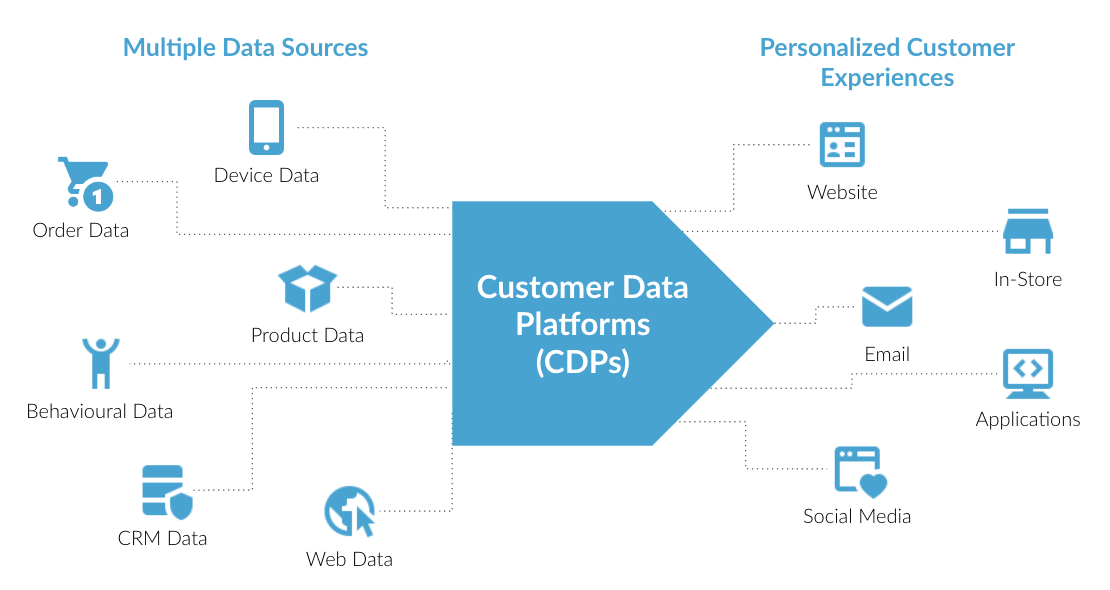Formally, the Customer Data Platform Institute defines Customer Data Platforms (CDPs) as "...packaged software that creates a persistent, unified customer database that is accessible to other systems."
In other words, CDPs are powerful solutions that help organizations manage and analyze customer data from disparate sources such as CRM systems or web analytics. CDPs allow marketers to gain a holistic 360-view of their customers by linking this customer data to a single profile, enabling them to create more tailored and memorable customer experiences. What's neat (or scary, depending on if you are still clinging to the hope that your personal data is not shared) is CDPs store customer data over time, using personal identifiers to track individual-level marketing results.

There are four primary categories of CDPs:
- Data CDPs collect, unify, and organize customer data from various sources into a comprehensive customer profile stored in a database available to external systems.
- Analytics CDPs provide data assembly as well as analytical applications, such as customer segmentation or machine learning.
- Campaign CDPs provide data assembly, analytics, and customer treatments, like personalized messages, content recommendations, or real-time interactions across multiple channels.
- Delivery CDPs include data assembly, analytics, customer treatments and message delivery through email, your website, mobile apps, or advertising.
What Kind of Data Is Collected by CDPs?
CDPs collect data from a number of different sources, including social media, loyalty programs, and email, as well as systems like customer relationship management (CRM) solutions and data management platforms (DMPs).
Types of data collected by CDPs include:
- Preferred channels
- Service history
- Personal contact information
- Spending behaviour
- Days most active
- Demographic information
- Transactional data
| Pros and Cons of CDPs for Marketers | |
|---|---|
Pros |
The ability to:
|
Cons |
|
What Is Sitecore CDP?
Sitecore Customer Data Platform (CDP) is a powerful, cloud-based platform that provides marketers with the tools to quickly and easily collect, manage, and analyze customer data to deliver more personalized and engaging experiences. By leveraging Sitecore CDP, marketers can access data insights to understand their customers better and target them more effectively.
Common use cases for Sitecore CDP include:
- Profile Unification: Sitecore CDP enables marketers to collect data from multiple sources and combine it into a single customer profile, enabling hyper-targeted personalization.
- Marketing Automation: Sitecore CDP can be used to automate personalized experiences, messages, and campaigns across multiple touch points, improving the efficiency and efficacy of your marketing efforts.
- Predictive Modeling and Analytics: Sitecore CDP provides advanced analytic capabilities to help marketers gain deeper insights into customer behaviour, as well as predictive capabilities to anticipate customer needs or preferences.
- Segmentation: Sitecore CDP allows marketers to segment customers into different groups based on common attributes, behaviours, or transactions. Segments can be used in the following ways:
- To provide personalized experiences.
- To filter audiences so you're showing the rights campaigns to the right audiences at the right time.
- To promote products or content.
- Data Visualization: Sitecore CDP provides powerful data visualization tools to help marketers quickly and easily visualize customer data, allowing them better understand their customers, identify patterns, and make more informed decisions
Benefits of Sitecore CDP for Marketers
Using Sitecore CDP, marketers can benefit from:
- Increased customer engagement and loyalty: Marketers can deliver more personalized and engaging customer experiences by leveraging more detailed customer data. The result? Increased customer engagement, loyalty, and, ultimately, more conversions.
- Improved ROI: With more granular insight into individual customer preferences, behaviour, and more, marketers can make better-informed decisions and optimize their marketing efforts, improving ROI.
- Reduced operational costs: Sitecore CDP eliminates the need for manual data collection and analysis. This results in reduced operational costs, freeing up resources which can be used to improve customer experiences even further.
Summary
In summary, Sitecore CDP is an incredibly powerful tool boasting an array of features and tools that enable marketers to deliver hyper-targeted customer experiences. With its data collection, storage, analysis, segmentation, and visualization tools, Sitecore CDP is the perfect solution for marketers looking to deliver best-in-class personalized customer experiences while driving conversions, improving ROI, and reducing operational costs.




